Industrial Food Animal Production
Background
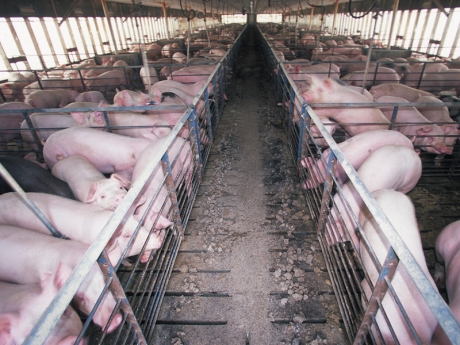
Sixty percent of hogs in the U.S. are produced in facilities that confine over 5,000 animals at a given time.2 Slats in the floor of this operation allow the animals’ waste to drop into a pit below the facility.
Photo credit: Jeff Vanuga, USDA Natural Resources Conservation Service.
The average American consumes more meat, milk, and eggs than nearly any other citizen of the world.1 Where do most of these animal products come from, and why does it matter?
For most of agriculture’s history, farm animals were raised on diversified farms, where they generally had access to the outdoors and ample space to move about. Although conditions like these still exist, the industrialization of agriculture radically transformed how most animals are raised for food.
At the end of 2012, the U.S. population of poultry, swine, cattle, and other food-producing animals numbered over 2 billion—outnumbering U.S. citizens by seven to one. Over the course of a typical year, over 9 billion are slaughtered.2 The vast majority of these animals are raised in a system called industrial food animal production, or IFAP (pronounced “eye-fap”).
In IFAP, poultry and swine are confined in densely stocked indoor facilities. A single IFAP facility, for example, typically houses over 5,000 hogs, or over 100,000 laying hens.2 Beef and dairy cattle spend at least part of their lives in similarly large-scale indoor or outdoor feeding operations.3,4 IFAP facilities are designed to maximize the amount of meat, milk, or eggs from a particular breed of animal in the shortest amount of time and at the lowest cost. They are also heavily dependent on specially formulated animal feeds, pharmaceutical drugs, fossil fuels, and other inputs to the production system.
IFAP produces an enormous amount of food with minimal human labor, and has been credited with lowering the price of meat, eggs, and milk.5 However, IFAP incurs heavy costs to public health and ecosystems that are not reflected in the sales price of these products.
Because IFAP is by far the dominant model of meat, milk, and egg production, it is the focus of this section. See also Ecological and Urban Agriculture, Food and Climate Change and Food Safety.
Waste Management
Large animal confinement factories… might drown in their own waste if they don’t haul it out whenever they can.
– Gene Logsdon, farmer6

Liquid manure from an Iowa hog facility being pumped onto cropland.
A single IFAP operation may produce as much waste as a small city,11 concentrated over a small area of land. To dispose of the waste, producers typically spread or spray it onto nearby fields, often in excess of what crops can use. The excess may pollute ground and surface waters with it bacterial pathogens, heavy metals, pharmaceutical drugs, and other contaminants.15
Photo credit: Tim McCabe, USDA Natural Resources Conservation Service.
Confining thousands or millions of animals in a small amount of space poses a challenge: what to do with the enormous amounts of feces and urine they generate? Poultry, swine, and cattle raised in U.S. operations produce an estimated 335 million tons of waste annually (not counting water weight)7—over 40 times the amount leaving sewage treatment plants.8 A single IFAP facility may produce as much waste as a small city,9 concentrated over a small area of land. To dispose of IFAP waste, producers typically spread or spray the manure onto nearby agricultural land.
When applied to crop fields, animal waste provides nutrients and organic matter that help crops grow, transforming waste into food. For this reason, farmers don’t typically think of it as “waste” and instead call it “manure.” IFAP facilities generate such a large quantity of waste in one place, however, that it is often much more than nearby crops can use—becoming a pollution problem rather than a source of fertility. When waste is over-applied, the excess may seep down into groundwater or be carried into nearby waterways as runoff (the flow of water,such as from rain or irrigation, over land). IFAP waste may also leak out of storage pits, or worse, overflow or rupture during heavy storms.10,11
Pollution from IFAP facilities is a public health and ecological problem because it may contain bacteria, viruses, parasites, veterinary drugs, hormones, heavy metals, excess nutrients, and other potentially harmful contaminants. People may be exposed to these hazards by drinking contaminated well water, for example, or by swimming and fishing in contaminated waters.8,12–13
Antibiotic Resistance
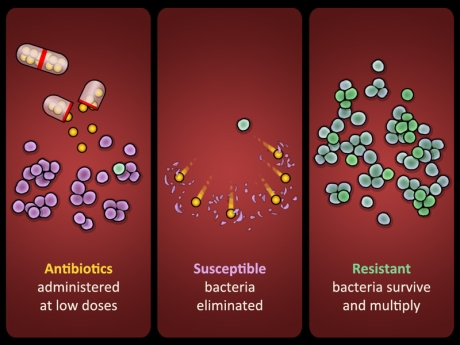
"The world is heading toward a post-antibiotic era, in which many common infections will no longer have a cure and, once again, kill unabated" – Margaret Chan, Director-General of the World Health Organization26
The non-medical use of antibiotics in food animal production creates an environment that favors antibiotic-resistant bacteria, eroding the effectiveness of lifesaving antibiotic drugs.
Image credit: Brent Kim, Johns Hopkins Center for a Livable Future, 2013.
In medicine, antibiotic drugs are used to kill or inhibit pathogens (disease-causing organisms), such as Staphylococcus aureus—bacteria that can cause skin, blood, and urinary tract infections. If a patient does not complete her or his full dose of antibiotics, however, they may succeed only in killing the most susceptible bacteria. Sir Alexander Fleming, who discovered the lifesaving antibiotic drug penicillin, warned in 1945 that “the ignorant man may easily underdose himself and by exposing his microbes to nonlethal quantities of the drug, make them resistant.” In a case of survival of the fittest, bacteria capable of surviving in the presence of the antibiotic grow and multiply. Eliminating the infection would then require treatment with a different antibiotic drug, or potentially several different drugs—and there are only so many different drugs available. For this reason, antibiotic-resistant infections are more difficult and expensive to treat,15 and potentially fatal.
Experiments in the 1940s and 1950s found that feeding low doses of antibiotics to animals caused them to gain weight faster and on less feed. These findings prompted the introduction of antibiotics to the diets of healthy poultry, swine, and cattle.16 By 2009, 80 percent of antibiotic drugs sold in the U.S. were used not for human medicine but for food animal production.17
The nonmedical use of antibiotics in food animal production creates an environment that favors antibiotic-resistant bacteria, eroding the effectiveness of lifesaving drugs. A growing body of evidence suggests pathogens (resistant or otherwise) spread from IFAP operations to nearby communities via workers,18,19 air,20–22 water,23 and flies,24 and to consumers via contaminated meat.25 These pathways add to the growing dangers of antibiotic-resistant infections.
Worker Health, Worker Justice
Who is responsible for the health and ecological problems of IFAP? Blame is sometimes targeted at the people who raise the animals. In many cases, however, they are as much a victim of an industrial system as they are a part of the problem.
In industrial swine and poultry production, for example, farmers (or “growers”) are often pressured into signing contracts with vertically integrated corporations that dictate how the animals must be raised.27 Signing a contract with an “integrator” often means taking out loans to build the required facilities. Debt can further pressure growers to accept the terms mandated by the integrator when it comes time to renew the contract. As one poultry grower said, “When you have that kind of debt load over you … you’re going to choose to sign the contract. You feel that there’s no other option when you owe … a million dollars.”27
People who raise animals in IFAP operations also face numerous health risks. Crowded conditions in IFAP operations present frequent opportunities for the transmission of disease-causing organisms between animals, and from animals to workers. IFAP workers may be responsible for handling animals, animal waste, and carcasses—all of which may harbor bacteria, viruses, and other pathogens, including antibiotic-resistant strains. Once infected, workers may spread these pathogens into their homes and communities.28
IFAP workers may also be exposed to a range of airborne hazards, including harmful gases emitted from animal waste, particles of dried feces and urine, animal dander, fungal spores, and bacterial toxins. These hazards contribute to a heavy health burden: at least one in four workers in indoor IFAP operations is estimated to have a respiratory illness such as asthma.29.30
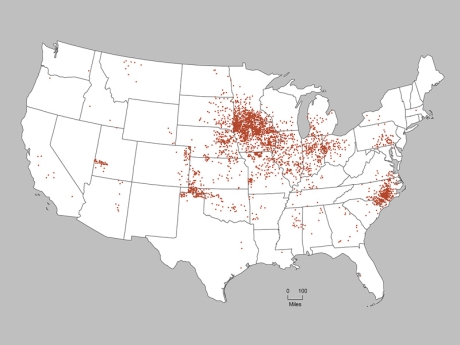
U.S. hog inventory, 2007. 1 dot = 20,000 animals.
IFAP has become concentrated within certain geographic areas. Hog production, for example, is concentrated in parts of North Carolina, Iowa, and the Midwest. Concentrating large numbers of animals, and their waste, intensifies the impact of IFAP on nearby communities and ecosystems.
Image source: USDA. Public domain.
Community Impacts
Living near IFAP often means coping with flies, odors, polluted air, contaminated water, and an environment populated by disease-causing pathogens.
Studies suggest bacterial pathogens, harmful gases, and other environmental contaminants may spread from IFAP facilities to surrounding communities, increasing residents’ disease risks. Contaminants may be brought into communities by workers,18,19 blown out of ventilation systems,20–22 introduced into drinking and recreational waters,8,12–14,23 and spread by flies, birds, and other animals.24,31 People living closer to IFAP operations (or where IFAP waste is applied) often have higher rates of illness, including respiratory problems32–37 and infections with antibiotic-resistant pathogens.38
Overwhelming odors from IFAP facilities can be a nuisance for nearby residents—interfering with daily activities, social gatherings, and overall quality of life. One North Carolina resident living near an industrial hog facility testified, “I think about the time everybody sat down to eat supper, we had all the windows closed, but you couldn't eat because the odor was just that strong … It's just like you could eat [your food], but as soon as you got up or went outside … you threw it back up.”39 More than just an unpleasant smell, odors from IFAP facilities have been associated with physical and mental health problems, including high blood pressure, depression, anxiety, and difficulty sleeping.40–42.
IFAP facilities and the problems they bring are often unwanted in communities. Proposals for the construction of new facilities are frequently met with strong opposition from local residents. IFAP facilities are disproportionately located in low-income communities and communities of color, where residents may have less political influence to oppose them—a form of environmental injustice.43
Animal Welfare
All the arguments to prove man's superiority cannot shatter this hard fact: In suffering, the animals are our equals.
– Peter Singer, ethicist
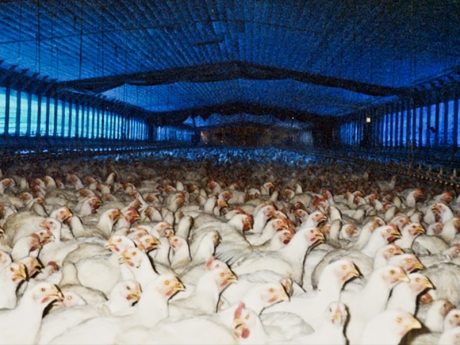
In industrial food animal production, most animals rarely if ever see the outdoors. They are unable to perform many of their natural behaviors, and are subjected to extreme stress, crowded conditions, and painful bodily alterations.
Photo credit: Farm Sanctuary. www.farmsanctuary.org.
To accommodate the industrial model, animals and their environments are engineered to maximize productivity. Raising animals indoors eliminates weather from the equation, giving producers greater control over temperature, lighting, and other factors that influence productivity.5 Specialized confinement facilities maximize the number of animals per area, and allow for automated feeding, watering, ventilation, and waste removal.44
As a result, most animals in IFAP rarely if ever see the outdoors, let alone feel sunshine, experience day or night, or walk on grass. They are unable to perform many of their natural behaviors; pigs raised on concrete are unable to root in the earth with their powerful nose discs, chickens are unable to dust bathe, cattle are fed unnatural diets of grain that cause painful liver abscesses. In most egg production facilities, hens are confined to “battery cages” so small they are unable to spread their wings. Female pigs (sows) used for breeding are confined to “gestation crates” in which they are unable to turn around or groom themselves.5,44,45
The stress and crowding of confinement can cause animals to become aggressive toward one another. To prevent pecking among laying hens, beaks are removed with a hot blade. Pigs’ tails are amputated to prevent them from being bitten. Bodily alterations to animals are usually performed without anesthesia or any other form of pain relief, partly because it is viewed as too costly, even though it is widely accepted that such alterations are painful.5,44,46,47 Bodily alternations are not unique to IFAP; practices such as castration and dehorning are common on pasture-raised farms.
These physical and psychological harms are among many others not described here.
Changing Diets, Policies, and Farming Practices
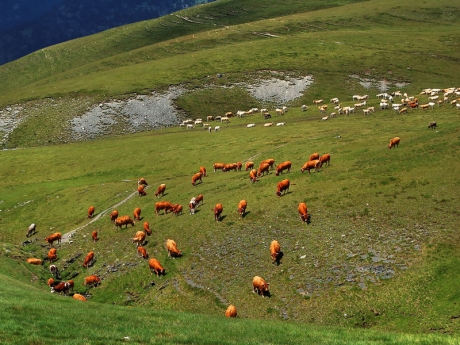
Herd of cows in the Pyrenees Mountains, France.
Pasture-raised animals can graze or forage on land that is too rocky or hilly for growing crops. In those cases, the animals are not competing with land that could be used to grow food crops for people.63
Photo credit: B. Monginoux, Landscape-Photo.net. Creative Commons CC BY-NC-ND 2.0 FR.
How can the harms of industrial food animal production (IFAP) be remedied? Changing diets, government policies, and the way animals are raised could all make a difference.
Changing diets
Each of our food purchases is a “vote with our fork” that sends a market signal affecting what, where, and how food is produced. In the words of farmer and author Wendell Berry, “How we eat determines, to a considerable extent, how the world is used.”48
Compared to typical high-meat diets, eating a diet of mostly plants requires less agricultural land (see image),49–52 and produces less nitrogen pollution49,52 and greenhouse gas emissions.49,52–57 Reducing meat and dairy consumption, particularly among high meat-consuming countries like the U.S., is an urgent and necessary step toward achieving a sustainable future.58
Changing policies
IFAP is enabled by weak environmental regulations and economic incentives. Strengthening restrictions on antibiotic use, improving the enforcement of air- and water-quality standards, and raising animal welfare standards are just a few of the policy changes that could improve the lives of workers, communities, and animals.5
Changing farming practices
Ecological approaches to livestock production typically involve raising animals outdoors (weather permitting), at lower densities, without growth-promoting drugs, and on diverse farms that cultivate a variety of crop or animal species. Well-managed pasture-based farms avoid many of the public health problems of IFAP, offer farmers greater autonomy, and allow animals freedom to express their natural behaviors. Pasture-based production is not a perfect solution, however, however, in part because it requires much more land (see image)59,60 and may produce more greenhouse gas emissions than industrial production.59–62
Resources
This list is a starting point for further exploration. Some materials may not reflect the views of the Johns Hopkins Center for a Livable Future.
For teachers
- Animals: Field to Factory (lesson plan). FoodSpan. Johns Hopkins Center for a Livable Future.
- The Hands That Feed Us (lesson plan). FoodSpan. Johns Hopkins Center for a Livable Future.
- Introduction to the US Food System: Public Health, Environment, and Equity (textbook). Neff RN (editor). Johns Hopkins Center for a Livable Future. 2014.
Reports
- Industrial Food Animal Production in America: Examining the Impact of the Pew Commission’s Priority Recommendations. Johns Hopkins Center for a Livable Future. 2013.
- Big Chicken: Pollution and Industrial Poultry Production in America. The Pew Environment Group. 2011.
- Putting Meat on the Table: Industrial Farm Animal Production in America. Pew Commission on Industrial Farm Animal Production. 2008.
- Blood, Sweat, and Fear: Workers' Rights in U.S. Meat and Poultry Plants. Human Rights Watch. 2004.
News and magazine articles
- Curb Antibiotic Use in Farm Animals. Keeve Nachman. Scientific American. 2016.
- The Ugly Economics of Chicken. Christopher Leonard. The Week. 2014.
- CAFOs and Environmental Justice: The Case of North Carolina. Wendee Nicole. Environmental Health Perspectives: News Focus. 2013.
- From Superbugs to Sustainability: a Fifth-Generation Producer's Mission to Raise Pigs without Antibiotics. Russ Kremer. The Huffington Post. 2013.
Films
- Frontline: The Trouble with Antibiotics. PBS. 2014.
- Out to Pasture: The Future of Farming? Johns Hopkins Center for a Livable Future and the Maryland Institute College of Art (MICA). 2010.
Academic journal articles
- Swine Farming Is a Risk Factor for Infection With and High Prevalence of Carriage of Multidrug-Resistant Staphylococcus aureus. Wardyn SE, Forshey BM, et al. Clinical Infectious Diseases. 2015.
- Interplay between policy and science regarding low-dose antimicrobial use in livestock (open access). Sorensen AC, Lawrence RS, Davis MF. Frontiers in Microbiology. 2014.
- High-Density Livestock Operations, Crop Field Application of Manure, and Risk of Community-Associated Methicillin-Resistant Staphylococcus aureus Infection in Pennsylvania (open access). Casey JA, Curriero FC, et al. JAMA Internal Medicine. 2013.
- Roxarsone, Inorganic Arsenic, and Other Arsenic Species in Chicken: A U.S.-Based Market Basket Sample (open access). Nachman KE, Baron PA, et al. Environmental Health Perspectives. 2013.
- Investigating the Role of State and Local Health Departments in Addressing Public Health Concerns Related to Industrial Food Animal Production Sites (open access). Fry JP, Laestadius LI, et al. PLOS One. 2013.
- Managing waste from confined animal feeding operations in the United States: the need for sanitary reform (open access). Graham JP, Nachman KE. Journal of Water and Health. 2010.
- Air Pollution and Odor in Communities near Industrial Swine Operations (open access). Wing S, Horton RA, et al. Environmental Health Perspectives. 2008.
- Community Health and Socioeconomic Issues Surrounding Concentrated Animal Feeding Operations (open access). Donham KJ, Wing S, et al. Environmental Health Perspectives. 2007.
References
1. U.N. Food & Agriculture Organization. FAOSTAT. 2013.
2. USDA. 2012 U.S. Census of Agriculture. 2014.
3. USDA Economic Research Service. Cattle: Background. 2012.
4. USDA Economic Research Service. Profits, Costs, and the Changing Structure of Dairy Farming. 2006.
5. Pew Commission on Industrial Farm Animal Production. Putting Meat on the Table: Industrial Farm Animal Production in America. The Pew Charitable Trusts and the Johns Hopkins Bloomberg School of Public Health; 2008.
8. Logsdon G. Holy Shit: Managing Manure to Save Mankind. White River Junction, VT: Chelsea Green Publishing Company; 2010.
9. USDA Agricultural Research Service. National Program 206: Manure and Byproduct Utilization (FY 2005 Annual Report).; 2005.
10. Graham JP, Nachman KE. Managing waste from confined animal feeding operations in the United States: the need for sanitary reform. J Water Heal. 2010;December:646-70.
11. American Society of Agricultural Engineers. Manure Production and Characteristics.; 2005.
12. Burkholder JM, Mallin MA, Glasgow HB, et al. Impacts to a coastal river and estuary from rupture of a large swine waste holding lagoon. J Environ Qual. 1997;26(6):1451.
13. Nicole W. CAFOs and Environmental Justice: The Case of North Carolina. Environ Health Perspect. 2013;121(June):A182-A189.
14. Thurston-Enriquez JA, Gilley JE, Eghball B. Microbial quality of runoff following land application of cattle manure and swine slurry. J Water Health. 2005;3(2):157-171.
15. Burkholder J, Libra B, Weyer P, et al. Impacts of waste from concentrated animal feeding operations on water quality. Environ Health Perspect. 2007;115(2):308-12.
16. Mallin MA, Cahoon LB. Industrialized animal production — a major source of nutrient and microbial pollution to aquatic ecosystems. Popul Environ. 2003;24(5):369-385.
20. Roberts RR, Hota B, Ahmad I, et al. Hospital and societal costs of antimicrobial-resistant infections in a Chicago teaching hospital: implications for antibiotic stewardship. Clin Infect Dis An Off Publ Infect Dis Soc Am. 2009;49(8):1175-84.
21. Gustafson RH, Bowen RE. Antibiotic use in animal agriculture. J Appl Microbiol. 1997;83(5):531-41.
22. U.S. Food and Drug Administration. Letter to The Honorable Louise M. Slaughter: Sales of Antibacterial Drugs in Kilograms. Washington D.C.; 2010.
23. Price LB, Graham JP, Lackey LG, Roess A, Vailes R, Silbergeld E. Elevated risk of carrying gentamicin-resistant Escherichia coli among U.S. poultry workers. Environ Health Perspect. 2007;115(12):1738-42.
24. Smith TC, Gebreyes W a, Abley MJ, et al. Methicillin-Resistant Staphylococcus aureus in Pigs and Farm Workers on Conventional and Antibiotic-Free Swine Farms in the USA. PLoS One. 2013;8(5):e63704.
25. Schulz J, Friese A, Klees S, et al. Longitudinal study of the contamination of air and of soil surfaces in the vicinity of pig barns by livestock-associated methicillin-resistant Staphylococcus aureus. Appl Environ Microbiol. 2012;78(16):5666-71.
26. Gibbs SG, Green CF, Tarwater PM, Mota LC, Mena KD, Scarpino P V. Isolation of Antibiotic-Resistant Bacteria from the Air Plume Downwind of a Swine Confined or Concentrated Animal Feeding Operation. Environ Health Perspect. 2006;114(7):1032-1037.
27. Chapin A, Rule A, Gibson K, Buckley T, Schwab K. Airborne Multidrug-Resistant Bacteria Isolated from a Concentrated Swine Feeding Operation. Environ Health Perspect. 2005;113(2).
28. Sapkota AR, Curriero FC, Gibson KE, Schwab KJ. Antibiotic-resistant enterococci and fecal indicators in surface water and groundwater impacted by a concentrated Swine feeding operation. Environ Health Perspect. 2007;115(7):1040-5.
29. Graham JP, Price LB, Evans SL, Graczyk TK, Silbergeld EK. Antibiotic resistant enterococci and staphylococci isolated from flies collected near confined poultry feeding operations. Sci Total Environ. 2009;407(8):2701-10.
30. Hayes JR, English LL, Carter PJ, et al. Prevalence and Antimicrobial Resistance of Enterococcus Species Isolated from Retail Meats. Appl Environ Microbiol. 2003;69(12):7153-7160.
31. Chan M. Combat drug resistance: no action today means no cure tomorrow. World Heal Organ. 2011.
32. Wise TA, Trist SE. Buyer Power in U.S. Hog Markets: A Critical Review of the Literature.; 2010.
33. Skov RL, Jensen KS. Community-associated meticillin-resistant Staphylococcus aureus as a cause of hospital-acquired infections. J Hosp Infect. 2009;73(4):364-70.
34. Donham K, Wing S, Osterberg D, et al. Community health and socioeconomic issues surrounding concentrated animal feeding operations. Environ Health Perspect. 2007;115(2):317-20.
35. Heederik D, Sigsgaard T, Thorne PS, et al. Health effects of airborne exposures from concentrated animal feeding operations. Environ Health Perspect. 2007;115(2):298-302.
36. Graham JP, Leibler JH, Price LB, et al. The animal-human interface and infectious disease in industrial food animal production: rethinking biosecurity and biocontainment. Public Health Rep. 2008;123(3):282-99.
37. Schinasi L, Horton RA, Guidry VT, Wing S, Marshall SW, Morland KB. Air pollution, lung function, and physical symptoms in communities near concentrated swine feeding operations. Epidemiology. 2011;22(2):208-15.
38. Mirabelli MC, Wing S, Marshall SW, Wilcosky TC. Asthma symptoms among adolescents who attend public schools that are located near confined swine feeding operations. Pediatrics. 2006;118(1):e66-75.
39. Radon K, Schulze A, Ehrenstein V, van Strien RT, Praml G, Nowak D. Environmental exposure to confined animal feeding operations and respiratory health of neighboring residents. Epidemiology. 2007;18(3):300-8.
40. Thu K, Donham K, Zigenhorn R, et al. A control study of the physical and mental health of residents living near a large-scale swine operation. J Agric Saf Health. 1997;3(1):13-26.
41. Bullers S. Environmental Stressors, Perceived Control, and Health: The Case of Residents Near Large-Scale Hog Farms in Eastern North Carolina. Hum Ecol. 2005;33(1):1-16.
42. Merchant J a., Naleway AL, Svendsen ER, et al. Asthma and Farm Exposures in a Cohort of Rural Iowa Children. Environ Health Perspect. 2005;113(3):350-356.
43. Casey JA, Curriero FC, Cosgrove SE, Nachman KE, Schwartz BS. High-Density Livestock Operations, Crop Field Application of Manure, and Risk of Community-Associated Methicillin-Resistant Staphylococcus aureus Infection in Pennsylvania. JAMA Intern Med. 2013;21205(21):1980-1990.
44. Environmental Defense Fund. Hogwatch Testimonials.; 1998.
45. Wing S, Horton RA, Rose KM. Air pollution from industrial swine operations and blood pressure of neighboring residents. Environ Health Perspect. 2013;121(1):92-6.
46. Wing S, Horton RA, Marshall SW, et al. Air pollution and odor in communities near industrial swine operations. Environ Health Perspect. 2008;116(10):1362-8.
47. Horton RA, Wing S, Marshall SW, Brownley KA. Malodor as a trigger of stress and negative mood in neighbors of industrial hog operations. Am J Public Health. 2009;99 Suppl 3:S610-5.
48. Donham KJ, Wing S, Osterberg D, et al. Community health and socioeconomic issues surrounding concentrated animal feeding operations. Environ Health Perspect. 2007;115(2):317-320.
49. Mason J, Finelli M. Brave New Farm? In: Singer P, ed. In Defense of Animals: The Second Wave. Oxford, England: Blackwell Publishing Inc; 2006.
50. Nagaraja TG, Chengappa MM. Liver abscesses in feedlot cattle: a review. J Anim Sci. 1998;76:287-298.
51. The Humane Society of the United States. An HSUS Report: The Welfare of Calves in the Beef Industry.
52. American Veterinary Medical Association. Literature Review on the Welfare Implications of Castration of Cattle. 2014.
53. Berry W. The Pleasures of Eating. In: What Are People For?. New York: North Point Press; 1990.
54. Westhoek H, Lesschen JP, Rood T, et al. Food choices, health and environment: Effects of cutting Europe’s meat and dairy intake. Glob Environ Chang. 2014;26:196-205.
55. van Dooren C, Marinussen M, Blonk H, Aiking H, Vellinga P. Exploring dietary guidelines based on ecological and nutritional values: A comparison of six dietary patterns. Food Policy. 2014;44:36-46.
56. Temme EHM, van der Voet H, Thissen JTNM, Verkaik-Kloosterman J, van Donkersgoed G, Nonhebel S. Replacement of meat and dairy by plant-derived foods: estimated effects on land use, iron and SFA intakes in young Dutch adult females. Public Health Nutr. 013;16(10):1900-7.
57. Meier T, Christen O. Environmental impacts of dietary recommendations and dietary styles: Germany as an example. Environ Sci Technol. 2013;47(2):877-888.
58. Tilman D, Clark M. Global diets link environmental sustainability and human health. Nature. 2014;515(7528):518-522.
59. Bajželj B, Richards KS, Allwood JM, et al. Importance of food-demand management for climate mitigation. Nat Clim Chang. 2014;4(10):924-929.
60. Hedenus F, Wirsenius S, Johansson DJA. The importance of reduced meat and dairy consumption for meeting stringent climate change targets. Clim Change. 2014;124(1-2):79-91.
61. Weber CL, Matthews HS. Food-miles and the relative climate impacts of food choices in the United States. Environ Sci Technol. 2008;42(10):3508-3513.
62. Popp A, Lotze-Campen H, Bodirsky B. Food consumption, diet shifts and associated non-CO2 greenhouse gases from agricultural production. Glob Environ Chang. 2010;20(3):451-462.
63. Kim B, Neff R, Santo R, Vigorito J. The Importance of Reducing Animal Product Consumption and Wasted Food in Mitigating Catastrophic Climate Change. Johns Hopkins Center for a Livable Future; 2015.
64. Nijdam D, Rood T, Westhoek H. The price of protein: Review of land use and carbon footprints from life cycle assessments of animal food products and their substitutes. Food Policy. 2012;37(6):760-770.
65. Pelletier N, Pirog R, Rasmussen R. Comparative life cycle environmental impacts of three beef production strategies in the Upper Midwestern United States. Agric Syst. 2010;103(6):380-389.
66. Capper JL. Is the Grass Always Greener? Comparing the Environmental Impact of Conventional, Natural and Grass-Fed Beef Production Systems. Animals. 2012;2(4):127-143.
67. Lupo CD, Clay DE, Benning JL, Stone JJ. Life-Cycle Assessment of the Beef Cattle Production System for the Northern Great Plains, USA. J Environ Qual. 2013;42:1386–1394.
69. Foley J a., Ramankutty N, Brauman K a., et al. Solutions for a cultivated planet. Nature. October 2011.
